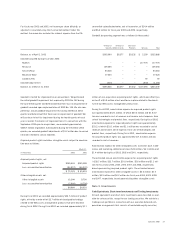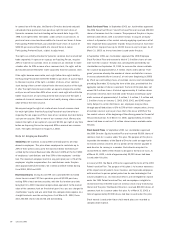Symantec 2003 Annual Report Download - page 69
Download and view the complete annual report
Please find page 69 of the 2003 Symantec annual report below. You can navigate through the pages in the report by either clicking on the pages listed below, or by using the keyword search tool below to find specific information within the annual report.
Symantec 2003 67
Appeals for the Federal Circuit reversed the judgment and remanded the
case. We intend to defend the action vigorously.
In July 1998, the Ontario Court of Justice (General Division) ruled that
we should pay a total of approximately $4.7 million for damages, plus
interest, to Triolet Systems, Inc. and Brian Duncombe in a decade-old
copyright action, for damages arising from the grant of a preliminary
injunction against them. The damages were awarded following the
court’s ruling that evidence presented later in the case showed the
injunction was not warranted. We inherited this case through our acqui-
sition of Delrina Corporation, which was the plaintiff in this lawsuit. Our
appeal of the decision was denied, and our request for further review of
that decision was also denied. We recorded a charge of approximately
$5.8 million during the June 1998 quarter, representing the unaccrued
portion of the judgment plus costs, and an additional charge of approxi-
mately $3.1 million for post-judgment interest and other costs during
the March 2002 quarter. In January 2003, we paid the judgment, inter-
est and costs of approximately $7.4 million. We expect to pay the
remaining accrued balance of costs upon further determination by the
court. As of March 31, 2003, we believe that we have adequately
accrued for both the damages and costs.
In October 1997, a complaint was filed in the United States District
Court for the District of Utah on behalf of PowerQuest Corporation,
against Quarterdeck, which we acquired in March 1999. The complaint
alleges that Quarterdeck’s partitioning software, included in Partition-It
and Partition-It Extra Strength, violated a patent held by PowerQuest.
In January 1998, PowerQuest obtained a second patent relating to parti-
tioning and has amended its complaint to allege infringement of that
patent as well. The plaintiff has added us as a defendant and seeks an
injunction against distribution of the Partition-It and Partition-It Extra
Strength products and monetary damages. We intend to defend the
action vigorously.
On September 15, 1997, Hilgraeve Corporation filed a lawsuit in the
United States District Court, Eastern District of Michigan, against us,
alleging that unspecified Symantec products infringe a patent owned by
Hilgraeve. The lawsuit requests damages, injunctive relief, costs and
attorney fees. In March 2000, the court granted our summary judgment
motions and dismissed the case. In September 2001, the Court of
Appeals for the Federal Circuit reversed the summary judgment and
ordered the case returned to the District Court. We intend to defend
the action vigorously.
Over the past few years, it has become common for software companies,
including us, to receive claims of patent infringement. At any given time,
we are evaluating claims of patent infringement asserted by several par-
ties, with respect to certain of our products. The outcome of any related
litigation or negotiation could have a material adverse impact on our
future results of operations or cash flows.
We are also involved in a number of other judicial and administrative
proceedings that are incidental to our business. We intend to defend all
of the aforementioned pending lawsuits vigorously. Although adverse
decisions (or settlements) may occur in one or more of the cases, and it
is not possible to estimate the possible loss or losses from each of these
cases, the final resolution of these lawsuits, individually or in the aggre-
gate, is not expected to have a material adverse affect on our financial
condition. Depending, however, on the amount and timing of an unfavor-
able resolution of these lawsuits, it is possible that our future results of
operations or cash flows could be materially adversely affected in a
particular period. We have accrued certain estimated legal fees and
expenses related to certain of these matters; however, actual amounts
may differ materially from those estimated amounts.
The total amount of legal and settlement expenses accrued as of the
respective year-ends, and the amounts expensed for the years then
ended, were as follows:
Balance as of March 31, 2003 $ 6.4 million
Amount expensed during fiscal 2003 $11.8 million
Balance as of March 31, 2002 $12.5 million
Amount expensed during fiscal 2002 $ 9.0 million
Balance as of March 31, 2001 $ 8.4 million
Amount expensed during fiscal 2001 $ 3.4 million
The legal expenses accrued by us are deemed probable because the law-
suits have been filed, management has determined its plans of action
with regards to the cases and, accordingly, knows that it will incur legal
expenses related to the particular lawsuit. Utilizing the assumptions
noted in Summary of Significant Accounting Policies under Legal
Expenses, management is able to estimate a minimum amount of legal
fees to be incurred in these lawsuits.
Note 16. Segment Information
Our operating segments are significant strategic business units that
offer different products and services, distinguished by customer needs.
We have five operating segments: Enterprise Security, Enterprise
Administration, Consumer Products, Services and Other.
The Enterprise Security segment focuses on providing Internet security
technology, global response and services necessary for organizations to
manage their information security needs. The Enterprise Administration
segment offers products that enable companies to be more effective
and efficient within their information technology departments. The
Consumer Products segment focuses on delivering our security and
problem-solving products to individual users, home offices and small
businesses. The Services segment is focused on providing information
security solutions that incorporate best-of-breed technology, security
expertise and global resources. The Other segment is comprised of
sunset products and products nearing the end of their life cycle. Also
included in the Other segment are all indirect costs, general and admin-
istrative expenses, amortization of goodwill (through March 31, 2002)
and other intangible assets, debt issuance costs and other assets and
charges, such as acquired in-process research and development, legal
judgments and settlements and restructuring and site closures which
are not charged to the other operating segments.
We shifted our focus to these operating segments during fiscal 2000,
with additional realignment in fiscal 2003, 2002 and 2001. Due to this





















